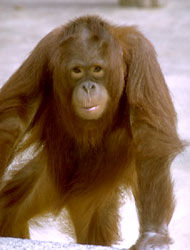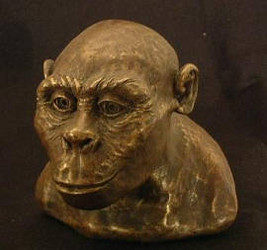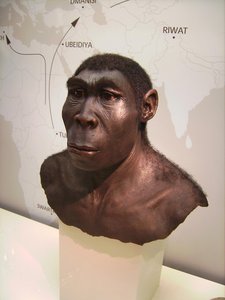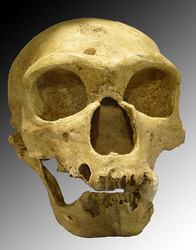Introduction
The concept of 'Good Nutrition' and 'Healthy Eating' are terms that have only recently become infused into households as evidence mounts to link today's prominent chronic diseases and food intake. However, research is mostly inconclusive, with disputes arising over required macronutrient ratios, organic/GM crops, processed foods and the validity and practicality of 'diets'.
What this treehouse will attempt to do, is to investigate the patterns of human nutrition over the course of the evolutionary timeline to see if prehistoric eating patterns and today's chronic diseases have anything in common. This will be done by not only using evolutionary biology, but also anthropology and the nutritional sciences.
This treehouse is not meant to discredit modern nutritional science or modern medicine, as they still have their necessary applications today, but rather to address the issues of health and nutrition on a more historical perspective.
Contents
- Primates
- Australopithecus africanus
- The genus Homo
- Homo sapiens in the Modern Age
- Conclusion
Primates
First, we'll look at the nutrition habits of non-human primates, moving from least-related to the most-related non-human primates to humans. Perhaps it may give us a glimpse of not only the types and qualities of foods ingested, but also the habits of obtaining and processing food.
The group we will specifically investigate is the Hominidae, which contains the most closely related species to the genus Homo. Below is the cladogram for Hominidae:


Relationships of Hominidae. © 2007 . Information obtained from Tree of Life Web Site.
Orangutans
Since it is the most distant relative in the Hominidae, we will start with the orangutan, Pongo.
Diet
About 60% of the orangutan's diet consists of fruit, including durians, jackfruit, lychees, mangosteens, mangoes and figs. The remainder of the diet is mostly young leaves and shoots, but also included are insects, mineral-rich soil, tree bark and woody lianas and occasionally eggs and small vertebrates. Much of their water is obtained from the fruit in their diet, but it is also drunk from tree holes1.
Feeding Behaviour
The species averages about 1/3 of its day foraging for food, and is most active in doing so during the early morning and late afternoon2.
Analysis
The orangutan seems to obtain the majority of its nutrients from plant-based sources, specifically simple and complex carbohydrates from the fruits and roots it consumes. Proteins seem to be obtained from the insects, small vertebrates and bark it eats, and possible sources of fatty acids are minimal but include oils from leaves and other vegetation, eggs, insects and small vertebrates. Activity is prolonged, so caloric intake has to compensate.
Gorillas
Gorillas are the next most closely related to the chimpanzees and human primates.
Diet
The diet of the gorilla depends on where it is located, in the east or west of Africa. In the Eastern population, the gorillas are mostly folivorous (meaning they generally eat leaves) - in one study this was 86% of the animal's diet. Galium vines, wild celery and three or four other species make up a high proportion of the diet. Small amounts of wood, roots, flowers, fruits, and grubs also are eaten.
In the Western population, fruits are the most important element in the gorillas’ diet, although they also eat leaves, pith and stems (e.g. wild ginger). In a study undertaken on one group in Gabon, it was found that the fruits of at least 95 plant species were utilized. Western gorillas also have been found to obtain termites through the bark of trees and wade through streams and rivers to harvest water plants. They also differ from the Eastern population in their greater use of animal-derived foods3.
Feeding Behaviour
Gorillas can use their incredible strength to break apart vegetation. An adult male for example can shred apart a whole banana tree to get to the interior tender pith. Also, they are very selective foragers, eating only specific parts of certain plants4.
Analysis
Since the nutritional quality of the food gorillas consume is quite poor, they need to eat a lot. A typical male gorilla can consume 40 lbs of vegetables a day to maintain a bodyweight that can range from 300-600 lbs for males5. This large intake of vegetables and fruits (carbohydrate based foods) is quite suboptimal. So as to counteract their great caloric need and available food, gorillas tend to sleep or rest on average about 76.5% of a 24 hour day, and feeding for only 12.5% of it6.
Chimpanzees and Bonobos
Chimpanzees and Bonobos are highly similar, key distinctions range from the chimpanzees being larger than the latter and the bonobos being more sexually active and having a more upright gait. Chimpanzee is a term that is commonly used to refer to both species.

Pan troglodytes. Photograph by Gerald and Buff Corsi, © 2002 California Academy of Sciences
Diet
Both species are omnivorous. Chimps eat a lower percentage of fruit and a higher percentage of insects and other meats as compared to bonobos. In long dry seasons when fruit is scarce, tree seeds, flowers, soft pith, galls, resin and bark become an important part of their diet. Termites are the most nutritionally important insects in their diet, Mammals such as monkeys, pigs and antelope are also eaten, particularly by males, but along with termites only account for about 5% of their diet. Females tend to consume more animals than the males7.
Feeding Behaviour
Foraging for fruits and leaves occurs normally, like in other species. Both species are highly opportunistic feeders. For example, if one chimpanzee starts hunting a red colobus monkey that has strayed into it's territory, all the monkeys in the group will start hunting it together. No distinction is made in the age of the individual being preyed upon, although a higher percentage of immature colobus monkeys are caught due to their availability and vulnerability. If the monkey caught is larger, then the meat is distributed amongst the group on basis of want (monkey's who want meat simply beg for it to receive it)8.
Analysis
Because of their social behaviour, diet and hunting patterns (as well as genetic and morphological similarities), chimpanzees are regarded as the closest non-human primate relatives to the genus Homo (and to modern humans). From the information presented here alone, it is notable that the chimpanzees possess the first instance of organized hunting and carnivory in hominids. Although the percentage of herbivory is still high, this is the first instance where other, larger mammals are being hunted in an organized fashion.


A group of chimpanzees, Pan troglodytes schweinfurthii, sharing a red colobus monkey after they have hunted and killed it. Note the chimpanzee on the right begging for food, which it will receive. © 2005
Other Primates
Other primates belonging to the Catarrhini but are not in Hominidae range from gibbons to the 'Old World Monkeys' such as baboons. Some species in these groups may be carnivorous (like baboons) and feed on other small mammals, however they do not display the organized social hunting behaviour present in chimpanzees and bonobos, and their diet still consists almost solely of roots, shoots, fruits and/or vegetables.
Shown below is the cladogram for Catarrhini, so that it can be seen where Hominidae falls in.


Relationships of Catarrhini. © 2007 . Information obtained from Tree of Life Website
As a short conclusion to this section, some things must be noted. Firstly, although these non-human primates consume mostly vegetables and fruits with rare and/or constrained protein intake, it is interesting to see how their strength to bodyweight ratios, and in the case of gorillas, mass, is much higher than that of humans. Activity is prolonged and/or intense at some times, and in others rest occupies the majority of the daily activities. Also, note that the diet of non-human primates is extremely varied, some species can consume upto a 100 different species of fruit in a single season.
Hence from this it is observable that the nutritional habits of non-human primates may be specific to their genetics and physiological makeup. This however, is just a hypothesis, as nine volunteers at a zoo in Devon, UK, followed a gorilla style diet and ended up making huge health gains. For more information see BBC News: Going Ape. This was in the absence of an exercise program that could have been similar to the physical activity done by non-human primates, which may have had some interesting results.
Australopithecus africanus
Since this species lived about 4-1.2 million years ago, the most that can be known about it is from fossil evidence.
Diet
In 1979, anthropologist Alan Walker, using fossil studies, established that Australopithecus was fruitarian. However, a revision of the study in 1992 using isotopes of strontium and calcium suggested that the species was instead omnivorous9. Also, the thick jaws, and large molars and premolars suggested that Australopithecus most likely consumed rough vegetable matter as the staple of their diet10. Moreover, a study on relating chimpanzee diets to that of this species, suggested that Australopithecus had a diet more similar to chimpanzees, than that of Homo sapiens11.
Feeding Behaviour
Not much is known about australopithecine feeding behaviour, although it has been suggested that they were similar to chimpanzees in the regard of being plant foragers chiefly, and opportunistic hunters second.
Analysis
Despite similarities, australopithecines still consumed less fiber than chimpanzees did11. This suggests that Australopithecus africanus initiated the shift to the hominid diet from vegetables and carbohydrates to a higher emphasis on lipids and proteins, although vegetables and plant based foods still constituted the mainstay of the diet. This will be explored further in the next section.
The Genus Homo
Three key species will be investigated here. Namely, Homo erectus, Homo neanderthalensis, and Homo sapiens. These species represent landmarks in the human evolutionary chain, particularly with respect to diet and feeding behaviour, as well as social development.
Homo erectus
Homo erectus is a descendant of the first (by discovery) Homo species, Homo habilis. Fossilized remains of the species date back to 1.8-1.0 million years ago. Remains have been found in Africa, Georgia (Europe), China and Indonesia.
Diet
Firstly, it is well documented that species such as Homo erectus employed the use of many stone-based tools to help in their daily activities. The style of some tools used lead archeologists to believe that they were used for cutting, specifically for meat. This suggests that there is a higher consumption of meat, which is also supported by the jaw and canine structure of the skulls, which were significantly altered as compared to Australopithecus.
Feeding Behaviour
Although it is not easily determined how Homo erectus foraged and gathered non-animal foods, it is assumed that like most early human hunter-gatherers, it was similar to the activity of Australopithecus and chimpanzees, i.e. generally just opportunistic foraging of vegetables, fruits, roots and shoots. An age-old argument in the anthropological community is over the source of animal protein and how it was procured. One argument is that the meat was hunted and killed, then taken back to families and shared12, while the other suggests that the meat was scavenged13 (obtained from fossil evidence in animal bones that bore a greater resemblance to tooth marks than tool marks). Both arguments have sufficient evidence to support their claims, but the scavenger theory proves to be more firm with its archeological evidence.
Analysis
The use of tools, particularly those designed to cut or puncture, emphasizes the growing importance of meat in early human society. The currently most accepted theory behind the increased intake of meats and protein is the 'Expensive Tissue Hypothesis', stating that an increased intake of meat was required for the gut to reduce in size and complexity so that more energy could be used to create a larger brain. This explains why as cranial capacity (brain size) increased, meat intake increased.
Homo neanderthalensis
Neanderthals, as the species is known, inhabited Europe and parts of Western Asia about 350,000 to 130,000 years ago. They became extinct in Europe at approximately 24,000 years ago14. They were built more robustly than Homo sapiens and some possessed a large cranial capacity too. There has also been a hypothesis and studies suggesting that perhaps Neanderthals and Homo sapiens interbred at one point15.
Diet
The diet of the Neanderthals is the source of today's popular Paleolithic diet. The emphasis lies heavily on the consumption of fatty meats and vegetables. This is based on evidence from the bones of Neanderthals, which through stable isotope analysis suggest that they were very dependent on meat in their diet. This leads many anthropologists to suggest that the Neanderthals were hunters, not scavengers, as scavenging would not have fulfilled their meat quota16.
Feeding Behaviour
Neanderthals are renowned for their hunting. Evidence beyond the stable isotope analysis include the large cranial capacity they possess, which according to the expensive tissue hypothesis suggests that they ate large amounts of meat. Other than that, Neanderthal skeletons have been found to posses many fractures, especially to the ribs, suggesting that many injuries resulted due to intensive and difficult hunting. Interestingly the fractures are similar to those suffered by rodeo clowns, suggesting that neanderthals may have hunted their prey by leaping on them or wrestling them to the ground17. Lastly, amongst their tools, large amounts of weapons have been found in the Neanderthal arsenal, suggesting once again that hunting was an important focus of life.
Analysis
The conclusion one can reach from analysing the Neanderthals is the growing importance of meat and hunting amongst the early humans leading up to Homo sapiens. It should be noted that the size and robustness of Neanderthal skeletons suggests that they were in fact physically strong and capable, although pathological studies on fossils suggest that degenerative disease from overuse was common, as was infection in times of food scarcity17.
Homo sapiens
Homo sapiens originated in Africa about 200,000 years ago. From then on we have grown to cover the entire globe, at a population of about 6.5 billion (as of 2007).

Homo sapiens. Courtesy Department of Library Services American Museum of Natural History (Neg. No. 105168).
Diet
The following information has been derived from lecture notes from my Anthropology of Food and Nutrition class, a Level II course run by Dr. Marjorie Cummings in McMaster University18.
For about 190,000 years, Homo sapiens followed a hunter-gatherer lifestyle similar to that of Homo neanderthalensis. Their diet consisted of the same wild game, fruits, vegetables and nuts.
Studies of indigenous populations who generally did not make the move to organised agriculture indicate that based on location, populations are mainly fruitarian, omnivorous, or carnivorous, although they still consume other foods.
For example the bushmen of the Kalahari consumed a diet that was omnivorous, and consisted of vegetables and nuts with 20% of the protein intake coming from wild game. General macronutrient ratios of protein, lipid and carbohydrate were almost equal (33% all round). Others, such as tropical islanders, consumed mostly a fruitarian diet. Eskimos and old Native Indians once consumed a diet that was almost 40-50% animal based fat, with 40% of the fat being saturated, and generally subsisted on a high-protein, high fat diet19.
The Agricultural Revolution 10,000 years ago marked a significant change in primate nutrition as the climate changed to allow the domestication and flourishing of wild grains. Cultivation of these grain crops allowed cities and culture to develop, yet increased the dependency on single crops and increased the spread of infectious disease.
Current nutritional trends have standardised macronutrient ratios and food choices for the entire global population, resulting in startling changes and new anomalies in human health and biological response.
Feeding Behaviour
Before agriculture, feeding behaviour was similar to the foraging and hunting of wild game conducted by Homo neanderthalensis.
As agriculture developed, cities and culture started to develop too. This resulted in greater class stratification and specialisation of duties, and the delegation of farming and food-harvesting duties to the lower and lower-middle class of farmers. This is the first instance in primate evolutionary history where food is actively grown and commodified, instead of being consumed as subsistence for survival.
Analysis
The alteration of feeding patterns, type of food consumed, and increased dependency on single crops has led mostly to social, cultural and political changes in Homo sapiens, especially until the 1900s. Health issues were mostly associated with malnutrition and increased rates of infectious disease, as well as periodic starvation when food was unavailable.
Homo sapiens in the 1900s
The food consumed by Homo sapiens in the past 100 years has changed much more rapidly than the food they consumed after the Agricultural Revolution. It can be seen, just by observing how nutrition has changed from the Orangutan to Homo sapiens, what exactly should form the background of a modern human's nutritionary profile. However, many things have changed, resulting in some deleterious effects on human health.
From the perspective of nutrition and evolutionary biology, things that have changed and resulting affected the health of the general human population include:
- Increased consumption of grain-based carbohydrates, especially of the variety that are highly processed and refined, causing an increase of type II diabetes20.
- Increased consumption of refined sugar (sucrose), previously unheard of in primate evolutionary history and general mammalian history, resulting in an increase of type II diabetes20.
- A possible link between increased usage of pesticides and fertilizers, and decreasing soil quality, resulting in reduced nutritional capacity of foods21.
- Increased possibility of organ damage and stunted growth as a result of ingesting genetically modified foods. The study with genetically modified potatoes and mice was conducted by Dr Árpád Pusztai in August 1998, whose studies were shut down by external political forces.
- Decreased intake of saturated and other necessary fats19.
- Heating and Irradiation of certain foods like milk, resulting in problems like increased lactose intolerance22.
- Increased use of hormones in foods, and increasing estrogenation of foods as a result of plastic usage23.
- Overall reduced consumption of fruits and vegetables, excess consumption of artificially processed foods.
- Lack of vegetable nutrition in consumed meats due to commercial farming of animals, fed corn and offal instead of nutritious and diverse vegetable diets.
- Chemicals like fluoride and arsenic in the water supply.
Other factors that could contribute to the increasing changes in human nutrition and health include:
- Increased levels of pollutants in the atmosphere.
- Increased total population and density.
- Unequal distribution of food due to class stratification and other political reasons.
- Changing water levels due to excess irrigation and global warming.
- Standardised nutrition systems for the global population without adjustments made for specific population. A good example of this are the titanic chronic disease and obesity rates in Eskimo and Native Indian population. Both consume refined wheat products and sugar in their diets, whereas before colonials arrived their diet was almost completely protein and lipid19.
Conclusion
Nutrition of the genus Homo has changed gradually over the course of a million years, up until recently when changes started occuring faster than evolutionary possible. This has resulted in some major problems, especially in the case of chronic disease. It would be wise to learn from our evolutionary past and implement a system of nutrition and healthcare based on that.
So what can you do to avoid the diseases yourself? At least from this treehouse's (and its author's) point of view:
- Eat organic.
- Eat enough vegetables and fruits.
- Do eat meat, but make sure it is organic and grass-fed.
- Avoid processed and refined foods.
- Eat only whole foods.










 Go to quick links
Go to quick search
Go to navigation for this section of the ToL site
Go to detailed links for the ToL site
Go to quick links
Go to quick search
Go to navigation for this section of the ToL site
Go to detailed links for the ToL site